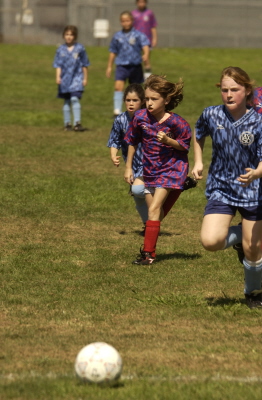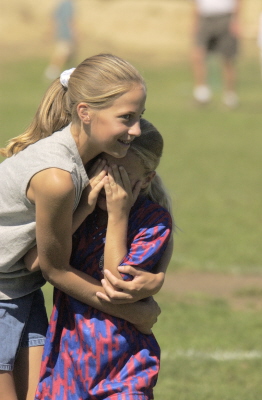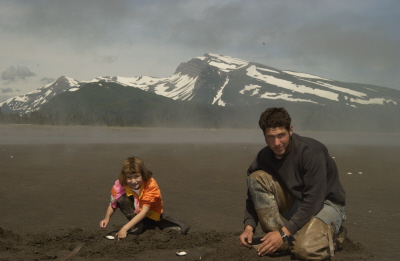Casual Digital for Pros
As a digital photographer you've probably developed a
sophisticated shooting and workflow system for your professional work. It's
worth the time and effort because you make the money back when you
license your images or prints.
You may have
developed an elaborate system of white balance setting, exposure compensation,
flash voodoo and Photoshop wizardry to try and make up for limitations of
your camera or printer. But when you want to take a few
shots on your "day off"--perhaps of your family or for a friend who has
kindly volunteered you to chronicle a local event--your time is no longer
being paid for and any extra headache getting the images right can quickly become
a chore. However, you still want the shots to look good as they reflect on
you and your reputation. |
 |
 |
This is what I call "Casual Digital" and this article will
help you out with some tips on how to make it fun and productive.
With the early digital cameras, early photo printers and early photo software color
correction was almost beyond explanation. It was so far beyond point & shoot that you could only nod and
say, "Yes, it's sort of complex."
For our professional shooting that has
been acceptable. We're paid to deal with odd shooting situations, trick
lighting, and lousy working conditions. Cropping and printing digital images might be a
pain, but it sure beats assembling a makeshift darkroom in your Hotel
bathroom! But what about the rest of the time? When we're shooting digital
for fun or for casual satisfaction, whether at a community event or just to
capture some images of a lifetime for our own family?
|
Until recently this has been a real chore. We've been forced to perform our
elaborate rituals of Raw files, Auto flash mode, Photoshop caste fixing and
balancing actions, and multiple color proofs just to get the modern equivalent
of the snapshot. It was close to turning casual photography from fun into a
drudge for me.
But five recent developments have really changed this picture, at least for
me. They have put the joy back into casual photography, helping ease the
drudgery of producing good photographs for a child's soccer team, a community
event, or a
Birthday Party. While they also help my workflow as a professional, their impact
on casual shooting is huge.
First, lenses. While the quality and performance of Nikon AF-S lenses or
the Canon USM equivalents is unparalleled, so is their size and weight! Fortunately,
for many casual shooting situations lighter and smaller lenses are available
with little compromise in image quality or functionality. For my D1X and D1H I
travel with the 18-35 and 24-85 zooms. They are substantially smaller, lighter,
and less intrusive than their bigger AF-S brothers. And often the 80-400 is a
good substitute for the larger 80-200 and TC combination. The only major exception to this
that I've found is for field sports. The slower focus of the 80-400 just doesn't
work very well for me in certain sports shooting situations such as
soccer--whether the athletes are Olympians or just neighborhood children.
Second, the color balance and improved flash metering on the Nikon D1X, D1H and the Canon 1D
makes a large difference. It is such a joy to use these
cameras when set to Adobe RGB--coupled with a computer monitor and printer also profiled. I can see, shoot, and view almost precisely the same image without
resorting to Raw mode, Photoshop actions, or black magic. Being able to use TTL
flash 90% of the time rather than 20% of the time is also a wonderful time
saver. To get the most out of your digital flash, be sure to read
Moose's article. If you have a D1 classic, Mike
Chaney's D1 profile or a custom built profile of your own can address most of
its shortcomings in this area.
Third, new Epson inkjets have pushed the ease of use boundary yet again. I
didn't think borderless printing was a big deal, and inch for inch the images
off my Epson 890 don't really look that different than from my older 1270. But
combining the borderless printing with an easier to profile printer in the 890,
I really feel like I have my own mini-lab. Instead of endless proofing and
profile tweaking, and slightly tacky looking torn edges I've got professional
looking 4x6, 5x7 or 8x10 prints with great color.
Just to repeat, I realize this isn't a solution for most professional work.
But for casual or hobby shooting, this is the most liberating development since
the mini-lab.
| Fourth, profiling software. I'm probably a masochist, but I
profile my printers with three different products. They're from Praxisoft, Horses
(now ColorVision) and Monaco. I've always wanted to make sure I was using
the best inexpensive profiling solution at any given time. Recently Monaco released EZColor 2.0. It has
really helped the colors on my Epsons. I now feel like I'm getting
reasonably
accurate color with the software-generated profile. You can do better with
multi-thousand dollar profiling systems, but this is casual digital,
remember! |
 |
| |
|
Fifth, for times when printing my own photos is just too much work, or I
want all the parents or community members to be able to produce their own
photos, online services are finally generating pretty darn good color. In
particular, Ofoto has been producing some very accurate prints and their
turnaround time seems to have shrunk dramatically since they have been bought by
Kodak. Shutterfly is a close second, but their website isn't as easy to use for
volume shooting and sharing, and they don't seem to be delivering nearly as
quickly as they used to. There are other niche players that have very good
quality, but these two also offer nice photo sharing solutions and are fairly
widely known so it's easier to tell your friends how to look for your images
there.
So, now there is at least a quick answer for casual digital shooting. A Nikon
or Canon digital SLR and a little elbow grease in setting up a digital
workflow. This is a great answer for those of us with pro cameras who are used
to using them. The industry still needs to solve three problems to bring these
benefits to the consumer audience: 1) white balance--Automatic white balance is still mostly
useless, 2) weight--2-1/2 pounds is not a Point & Shoot!, and 3) ease of
workflow--consumers won't mess with all these different pieces to make things
happen.
The final piece of this puzzle is obviously a more casual camera. The Nikon
Coolpix 5000 is the closest I've seen to a full function digital camera in a
point and shoot form factor. It is faster than other compact digitals and has
stunning image quality for a compact. We'll be writing more about it here on
nikondigital.org over the coming weeks.
--David Cardinal
|